The Hart’s Mill complex is a group of buildings on the Port Adelaide waterfront that includes Hart’s Mill, the Adelaide Milling and Mercantile Company flour mill, and associated outbuildings and other structures. Together, they constitute South Australia’s longest continually operating flour production facility, one that spanned a 125-year period between 1855 and 1980. The Adelaide Milling and Mercantile Company mill is currently the tallest building in Port Adelaide, and Australia’s tallest building with internal timber-framed architecture. Virtually derelict for approximately three decades, the complex of structures has in recent years been targeted for demolition and/or re-development, but has also become a venue for artistic expression and a rallying point for heritage protection and community action in the Port.
Hart’s Mill
The Hart’s Mill complex has its origins in the construction of a multi-storey flour production facility at Prince’s Wharf in 1855. Captain John Hart, for whom the mill is named, was the major shareholder in its establishment and operation. An English mariner who arrived in Western Australia in 1829, Hart spent the next decade operating coastal trading vessels in Australian waters. Following the loss of two vessels under his command, Hart invested in the shore-based whaling station at Encounter Bay, and managed the facility between 1839 and 1846. He retired from the sea completely in 1846 and moved to Adelaide, where he bought and leased land in various parts of South Australia, acted as an agent for absentees, and drove cattle. For the remainder of the 1840s, Hart invested in copper mines at Burra, Paringa, Montacute, Princess Royal, Mount Remarkable and Yorke Peninsula. He would later be implicated in the Great Northern Copper Mining scandal, but was ultimately exonerated of involvement. Hart was a parliamentarian during the 1850s and early 1860s and served as South Australia’s Premier (a title he introduced) during the years 1865-66, 1868 and 1870-71.
Hart’s Mill was built as a collaborative venture between John Hart and Henry Kent Hughes, a pastoralist who formed a business association with Hart in 1854. Other investors in the enterprise included James Brunskill and Messrs. Collinson, Sismey and Overton. The mill comprised a five-storey stone building measuring 68 feet (20.7 metres) in length, 47 feet (14.3 metres) wide, and 48 feet (14.6 metres) high. A smaller single-storey structure that housed the engine and boilers for the milling machinery abutted the mill at its southwest end. It too was built of stone and copied the style of the main building. The engine room, which measured 47 feet (14.3 metres) long and 44 feet (13.4 metres) wide, increased the overall length of the mill structure to 112 feet (34.1 metres). During construction of the mill’s foundation, great care was taken to account for the ‘soft nature of the soil’ in Port Adelaide—with the result that each wall featured footings with a height of six feet (1.8 metres). Stone quoins were also added at each corner to provide additional load-bearing strength to the overall structure.
The mill’s power-plant consisted of twin two-cylinder steam engines built by London-based manufacturing firm Easton & Amos. Each engine was capable of generating 30 horsepower, and was connected via geared wheel and pinions to a pair of counter-shafts. These shafts in turn powered ten pairs of millstones ‘of novel construction’ that could produce greater quantities of flour while simultaneously generating less friction than standard millstones then in use. An upright shaft outfitted with several smaller ‘lay shafts’ powered the mill’s machinery, including an apparatus that used silk mesh to dress (sift) the flour to a fine texture. As a result of the mill’s increased production capacity, its employees were able to examine and ensure the quality of flour with greater frequency. ‘Hart’s Flour’ soon earned a reputation for quality not only in South Australia, but throughout the British Empire, and commanded Australia’s highest flour prices for several years. The success of Hart’s Mill also fundamentally transformed the milling industry in colonial South Australia, which within 50 years would contribute substantially to Australia’s status as the world’s eighth largest wheat producer.
Hart’s Mill officially opened on 9 April 1855. Included among its thirty employees were several Kaurna people. This was significant, given that it was uncommon practice in the 1850s for Australian industry to hire Indigenous workers. John Hart reportedly treated his Aboriginal employees with fairness and respect, and also encouraged European settlers in Port Adelaide to refrain from killing and consuming black swans. In Kaurna culture, black swans are associated with Kudlyo Munaintya (Black Swan Dreaming) and are the totem of Kaurna who inhabit the region surrounding the Port River.
Adelaide Milling and Mercantile Company
John Hart died in January 1873. His milling operation saw continued success for another nine years, but ultimately merged with three other business enterprises to form the Adelaide Milling and Mercantile Company (AMMC). In an effort to keep up with the demand for South Australian flour, AMMC built a second, larger milling facility immediately to the west of Hart’s Mill. Completed in 1888, the new building was six storeys high and built entirely of brick—save for its stone foundation. As had occurred with Hart’s Mill, it was outfitted with an engine room, but in this case the purpose-built structure was isolated from the main building and situated a short distance away to the east.
As flour production shifted to the new mill, Hart’s Mill became the company’s primary storage facility for bagged flour and smaller quantities of bagged wheat. The old mill’s exact capacity is not specified in historical sources, but it reportedly contained 20 000 bags of flour and wheat when a fire gutted the new milling facility in 1905 (see below). New structures were added to the mill complex as it expanded to meet ever-increasing demand for flour. These included a corrugated iron shed adjacent to Hart’s Mill that functioned as a staging area capable of holding approximately 400 tons of bagged flour. A railway line entered the shed, thereby facilitating direct shipment of flour from the mill to nearby wharves or interstate train stations. The shed also housed AMMC administrative offices.
Mill Fires
Fine dust generated from flour production is highly combustible, and when dispersed in high concentrations in enclosed spaces with atmospheric oxygen and an ignition source (such as coal-fired steam machinery) it can generate an explosion and/or fire. Not surprisingly, the Hart’s Mill complex was damaged by fire on at least four separate occasions during the tenure of its operation. Two of these blazes, in 1890 and 1921, occurred in the old mill building and originated in the engine room and top floor, respectively. In the latter instance, the top floor room where the fire occurred contained a ‘preliminary cleaning machine, three motors, and other appliances’. It was also situated immediately above a silo containing 3500 bags of untreated wheat. Similarly, at the time of the 1890 blaze Hart’s Mill was reportedly ‘well stacked with wheat, flour, and other grain’. While the source of each fire was the subject of much subsequent debate, it seems very likely that machinery in the building ignited dust emanating from wheat and flour stored nearby.
Two other fires damaged the Hart’s Mill complex in 1905 and 1939. The first of these, on 14 March 1905, proved particularly devastating. Shortly after 6:00PM, a fire was observed in the ‘smut room’ on the top floor of the AMMC milling facility. The smut room housed a ‘smutter’—a machine used to clean unprocessed wheat of dirt and dust, which in turn is removed to an adjacent ‘dust room’ via an exhaust fan. As with previous occurrences of fire at the mill complex, it seems likely one of the machines ignited dust generated during the milling process. However, in this instance the consequences would be particularly dire.
The height of the building was perhaps the single biggest contributor to the fire’s speed and ferocity. Because there were no other structures around the mill tall enough to create a wind break, it—and the fire burning within its top storey—was exposed to the full force of a stiff south-westerly wind. This issue was exacerbated by the limitations of equipment available to the Port’s firefighting brigades, as well as their inability to get above the blaze and pour water into it. Within a very short time, the fire spread to all floors of the building, and sparks and embers generated by the conflagration posed an immediate threat to large stockpiles of wheat and flour in open storage throughout the complex. Several bags caught fire, but were extinguished before being completely consumed. Portions of Hart’s Mill and the iron staging shed also briefly ignited, but were saved by firefighters. At nearby Prince’s Wharf the upper rigging of the French barque Favell was set alight by embers, but the flames were quickly put out by its crew. In short order, Favell was warped into the middle of the Port River and out of harm’s way.
At its peak, the conflagration generated enough heat to cause the mill’s walls to glow ‘red hot’ and expand outward to such an extent that they appeared to ‘swerve…from the perpendicular’. Incredibly, the building maintained enough structural integrity to remain standing, and as the blaze subsided its walls ‘gradually returned to something like their original position’. By the following morning the mill was completely gutted, and all machinery and several tons of unprocessed wheat within it destroyed. Losses suffered by the company totalled approximately £20 000; however, these costs were covered by insurance.
Thirty four years later, another fire broke out in the top floor of the AMMC milling facility, but was quickly brought under control by the Port’s firefighters. This time, the blaze originated in a wheat room and resulted in damage to the roof, as well as some machinery and associated belting. Saltwater used to suppress the fire was ultimately successful, but had the unintended consequence of ruining a store of wheat that was being prepared for milling. Port Adelaide’s firefighting vessel, Fire Queen, was placed on standby to assist combating the blaze, but proved unnecessary. The 1939 incident would be the last major fire suffered by the Hart’s Mill complex prior to its closure in 1980.
Recent Events
Since AMMC’s closure, the buildings within the complex have remained largely vacant. In recent years, plans—many of which would potentially result in significant alteration and/or demolition of the mill’s outbuildings—have been put forward to develop the property. Both Hart’s Mill and the Adelaide Milling and Mercantile Company building are listed on South Australia’s Heritage Register, as are elements of associated stone and masonry walls, and the brick and corrugated iron façade of the packing shed. However, the corrugated iron structures that make up the rest of the complex are not protected by heritage legislation, and susceptible to demolition should development proceed. In addition, some developers have proposed construction of several multi-storey buildings that would effectively block the mill complex from view and significantly alter Port Adelaide’s surviving historic waterfront.
In response, a Port Adelaide-based community alliance has formed in recent years to advocate for more sustainable models of developing the property. The group has placed particular emphasis on preserving the historic fabric of all of the mill’s structures, and maintaining their prominent appearance on the landscape. As a means of promoting the Hart’s Mill complex as a multi-use communal space, the alliance has also hosted a variety of events at the site, including open-air markets, a projection art show, and the Adelaide leg of the 2014 St. Jerome’s Laneway Festival.


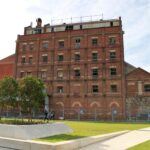

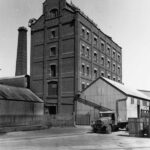
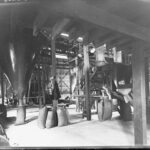
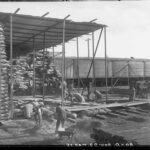
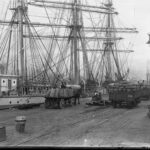
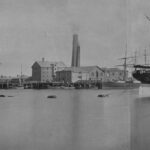

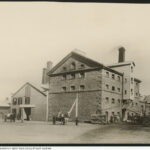
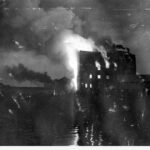


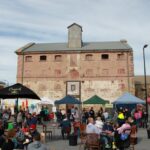
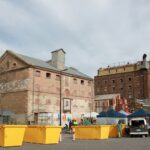


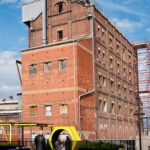

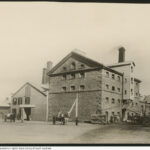
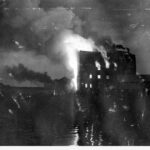

Comments
6 responses to “Hart’s Mill Complex”
I am wondering if anyone can help me trace the history of a photograph I have? It shows a football team circa 1890s(?) wearing guernseys saying “Adelaide Milling Coy. Ltd. Patent Roller” and featuring an Emu. They are standing in front of a sloping brick wall with dense trees/foliage behind that. I am very curious re a date, location and name of the club.
I’ll look into it Shane, if we can’t find anything on file perhaps you can send us a copy – sahistoryhub@history.sa.gov.au and we’ll put it on our social media platforms to see if anyone can help.
Are there tours of Hart’s Mill?
I don’t think they’re running currently Jennifer, but if you get in touch with the Harts Mill Project they may be able to tell you more – http://www.hartsmillproject.org/
I think my great great great grandfather worked at this mill in the 1850’s, wondering if there are any records of employees from that period. Hunting for more details of him!
I’m not sure about records of employment Wendy, but you can find the references for the material James used in researching this article under the ‘Sources’ section above – that might give you some leads.